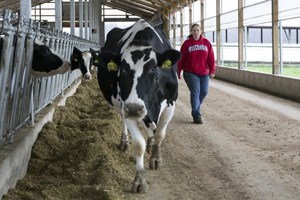JANUARY 2018
Communication is key.
 Although this overly-heard cliche provides no solution, it’s a good reminder of the importance of communication. To put it simply, when communication is bad, things don’t go well. This is no different for the agriculture community. Whether communication takes place between ag-producers, ag-experts, or through media channels, it plays an incredibly important role in keeping ag-safety information relevant and up-to-date.
Although this overly-heard cliche provides no solution, it’s a good reminder of the importance of communication. To put it simply, when communication is bad, things don’t go well. This is no different for the agriculture community. Whether communication takes place between ag-producers, ag-experts, or through media channels, it plays an incredibly important role in keeping ag-safety information relevant and up-to-date.
Agricultural communication professor at the University of Minnesota, Dr. Rebecca Swenson, recognizes communication as an essential factor in agriculture and acknowledges the need for improvement. “There is a high need to implement safety but low attendance at workshops and training sessions,” said Dr. Swenson.
“There is a high need to implement safety but low attendance at workshops and training sessions.”
Rebecca Swenson, PhD
Assistant Professor – Agricultural, Food, and Natural Resource Communication
University of Minnesota
Dr. Swenson is the principal investigator of the UMASH-funded pilot project Communication Strategies to Support Agricultural Innovations and Engagement. The pilot project was designed to identify and better understand the communication messages about safety within the Minnesota dairy farm industry. “The focus was on how to measure and evaluate communication strategies, and how to better engage producers,” said Dr. Swenson.
The pilot project was designed in two phases that involved both dairy producers and agricultural bloggers and journalists. Using methods such as surveys, farm visits and phone interviews, the first phase was a compilation of extensive research on Minnesota mid-sized dairy farm producers. The research zeroed in on questions regarding dairy producers’ attitudes and beliefs about stockmanship, new handling techniques, approaches for safety communication, strategies to increase motivation for safe behavior, preferred channels of communication, and reactions to UMASH training materials.
Dr. Swenson believes one of the biggest outcomes of this project was the importance of approaching producers with a “train-the trainer” communication model.

“It gives the producer resources to train their workers,” says Dr. Swenson, “and it gives them the opportunity to learn while they teach.” According to the survey, producers were much more concerned with safety training for their workers and less concerned with their own knowledge. The “train-the trainer” communication framework and resources enable producers to better engage farm workers to improve safe stockmanship practices and skills.
The second phase of the project was a content analysis of ag-media safety and stockmanship messages. The analysis examined more than two hundred mainstream agriculture media articles for a variety of specific items such as the article’s focus and safety solutions.
The findings suggest that media safety messages are found primarily in news stories regarding farm injuries, and there is a lack of content that shares preventable safety tips and strategies. “Journalists struggle to find a local angle with safety coverage and to write about more than accidents,” says Dr. Swenson. “They want help from organizations to develop more stories that aren’t simply about a tragedy, for example, stories with more local statistics, personal impact, or research.” Dr. Swenson believes that finding alternative ways to put safety messages in the media will combat these media safety norms. “Awards or case study-based stories would be a helpful way to get more messages about safety in the news,” says Dr. Swenson.
By giving a voice to both ag-producers and ag-media, Dr. Rebecca Swenson has found solutions to promoting safety on the farm. The findings and suggestions push for a transition out of traditional agriculture communication strategies and into a new era of ag-safety content.
The project was funded by the Upper Midwest Agricultural Safety and Health (UMASH) Center’s pilot project program.
